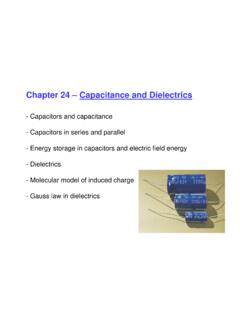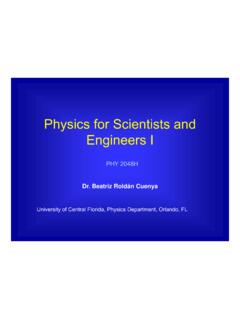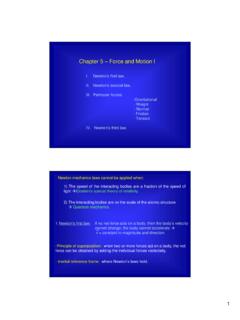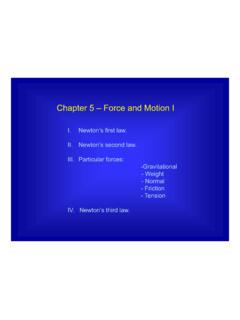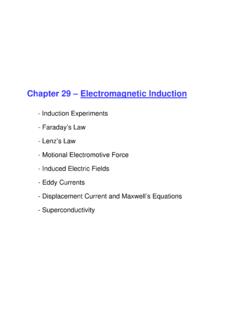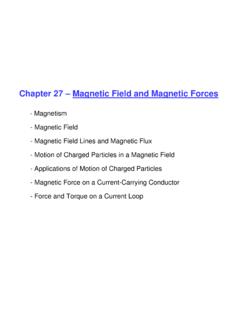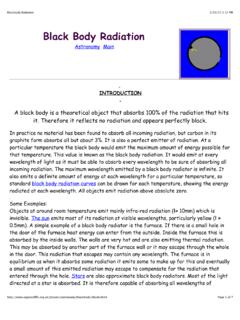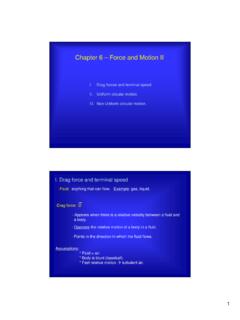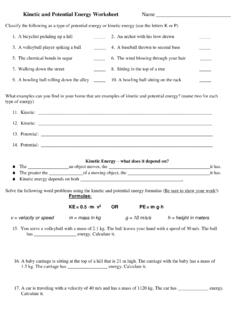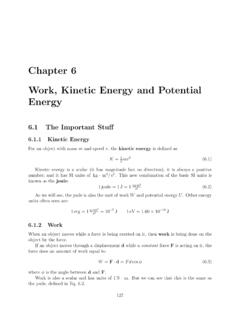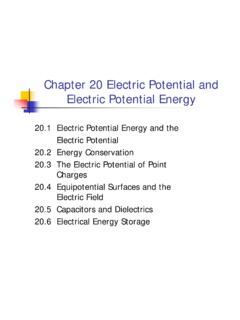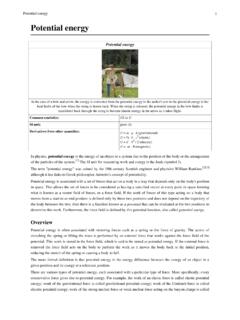Transcription of Chapter 7 – Kinetic energy, potential energy, work
1 Chapter 7 Kinetic energy , potential energy , Work - Kinetic energy Work done by a constant force: Gravitational forceV. Work done by a variable Spring General: 1D, 3D, Work- Kinetic energy TheoremVI. PowerVII. potential energy energy of configurationVIII. Work and potential energyIX. Conservative / Non-conservative forcesX. Determining potential energy values: gravitational potential energy ,elastic potential energyI. Kinetic energyEnergy associated with the state of motion of an object.) (212mvK Units: 1 Joule = 1J = 1 kgm2/s2 = N mII. WorkEnergy transferred to or from an object by means of a force acting onthe +WFrom -W- Constant force: xxmaF dvvadavvxx22202202 Work done by the force = Energytransfer due to the :scalar quantity associated with a state (or condition) of one or more objects.
2 (211)(21202202vvmdmadvvmmaFxxx dFWdFKKvvmxxif )(21202-To calculate the work done on an object by a force during a displacement,we use only the force component along the object s displacement. Theforce component perpendicular to the displacement does zero work.) (cosdFdFdFWx - Assumptions: 1) F=cte, 2) Object WWUnits: 1 Joule = 1J = 1 kgm2/s2A force does +W when it has a vector component in the same directionas the displacement, and W when it has a vector component in theopposite direction. W=0 when it has no such vector work done by several forces = Sum of works done by individual ) Fnet Wnet=FnetdCalculation:1) Wnet= W1+W2+W3+..Fdcos II. Work- Kinetic energy Theorem) (WKKKif Change in the Kinetic energy of the particle = Net work done on the particleIII.
3 Work done by a constant force- Gravitational force: ) (cos mgddFW Rising object:W= mgd cos180 = -mgd Fgtransfersmgd energyfromthe object s Kinetic object:W= mgd cos 0 = +mgd Fgtransfers mgd energytothe object s Kinetic Work done by a variable force- External applied force + Gravitational force: ) (gaifWWKKK Object stationary before and after the lift:Wa+Wg=0 The applied force transfers the same amount ofenergy to the object as the gravitational force transfers from the Spring force: ) (dkF Hooke s lawk= spring constant measures spring :N/mkxFDx 1 Work done by a spring force:Hooke s law- Assumptions: Spring is massless mspring<< mblock Ideal spring obeys Hooke s law exactly. Contact between the block and floor is frictionless.
4 Block is ) F(x) cte within each short x Calculation:xFxxixf xFj1) The block displacement must be divided into many segments of infinitesimal width, done by an applied force + spring force:dxkxdxFWxxFWfifixxxxsjs )(0222121fisxkxkW Ws=0 If Block ends up at xf= ifsxifxkWsaifWWKKK Block stationary before and after the displacement: K=0 Wa=-Ws The work done by the applied force displacing the block is the negativeof the work done by the spring force. )(2121222ifxxxxSxxkxkdxxkWfifi Work done by a general variable force:1D-Analysis) ()(0,,0,,lim fixxavgjxavgjjavgjjdxxFWxFWxxmoreionappr oximatbetterxFWWxFWGeometrically:Work is the area between the curve F(x) and the energy Theorem - Variable force fifixxxxdxmadxxFW)(3D-Analysis)(),(),(; zFFyFFxFFkFjFiFFzyxzyx kdzjdyidxrd fifififizzzyyyxxxrrzyxdzFdyFdxFdWWdzFdyF dxFrdFdW dxdtdvmdxma KKKmvmvdvvmdvmvWififvvvvfifi 222121 vdxdvdtdxdxdvdtdvmvdvdxvdxdvm V.
5 PowerTime rate at which the applied force does Average power: amount of work done in an amount of time t by a Instantaneous power: instantaneous time rate of doing work.) (tWPavg ) (dtdWP Units:1 Watt=1W=1J/s1 kilowatt-hour = 1 kW h = x 106J= ) (coscoscosvFFvdtdxFdtdxFdtdWP xF the figure (a) below a 2N force is applied to a 4kg block at a downwardangle as the block moves rightward through 1m across a frictionless floor. Findan expression for the speed vfat the end of that distance if the block s initialvelocity is: (a) 0 and (b) 1m/s to the right. (c) The situation in (b) is similar in thatthe block is initially moving at 1m/s to the right, but now the 2N force is directeddownward to the left.
6 Find an expression for the speed of the block at the end ofthe 1m )( )cos(202vvmKWdFdFWf NmgFxFysmvJvkgNJmvKsmvcfff/cos12)4( )2( )(220 smvvkgNmvKvafff/cos)4( )2( )(220 smvJvkgNsmkgmvKsmvbfff/cos12)4( )2()/1()4( )(2220 the figure below a horizontal force Faof magnitude 20N is applied to a 3kgpsychology book, as the book slides a distance of d= up a frictionless ramp.(a) During the displacement, what is the net work done on the book by Fa,thegravitational force on the book and the normal force on the book? (b) If the bookhas zero Kinetic energy at the start of the displacement, what is the speed at theend of the displacement?workdoFFOnlyWdNaxgx,0 ) (30sin30cos20)( )(20 2kg lunchbox is sent sliding over a frictionless surface, in the positivedirection of an x axis along the surface.
7 Beginning at t=0, a steady wind pusheson the lunchbox in the negative direction of x, Fig. below. Estimate the kineticenergy of the lunchbox at (a) t=1s, (b) t=5s. (c) How much work does the forcefrom the wind do on the lunch box from t=1s to t=5s?)10(101ttxparaboladownwardconcaveMo tion ) )(2( )(2 JKvstbff005)( )1()5()( 2 ) )( ( ) )(2(22ttNxFWNsmkgmacteF 74.(a) Find the work done on the particle by the force represented inthe graph below as the particle moves from x=1 to x=3m. (b) The curveis given by F=a/x2, with a=9Nm2. Calculate the work using )1)( )( ()( JxdxxWb6)131(9199)(31312 elevator has a mass of 4500kg and can carry a maximum load of1800kg. If the cab is moving upward at full load at , what power isrequired of the force moving the cab to maintain that speed?
8 (6300(006300180045002 ) )( ( A single force acts on a body that moves along an x-axis. The figure below showsthe velocity component versus time for the body. For each of the intervals AB, BC,CD, and DE, give the sign (plus or minus) of the work done by the force, or statethat the work is 202021vvmKKKWff 0 WvvBCBC0 WvvCDCD00,0 WvvDEDE0 250g block is dropped onto a relaxed vertical spring that has a springconstant of k= The block becomes attached to the spring andcompresses the spring 12 cm before momentarily stopping. While the spring isbeing compressed, what work is done on the block by (a) the gravitational force onit and (b) the spring force? (c) What is the speed of the block just before it hits thespring?))
9 (Friction negligible) (d) If the speed at impact is doubled, what is themaximum compression of the spring? ) )( )( ()(2 ) )(/250( )(22 ) ( )(2222 '' ' '0? ')(22 the figure below, a cord runs around two massless, frictionless pulleys; acanister with mass m=20kg hangs from one pulley; and you exert a force F on thefree end of the cord. (a) What must be the magnitude of F if you are to lift thecanister at a constant speed? (b) To lift the canister by 2cm, how far must you pullthe free end of the cord? During that lift, what is the work done on the canister by(c) your force (via the cord) and (d) the gravitational force on the canister?NmgFFTcordHandNTmgTFctevPulleya net9820:98020:1)( ) )(98()( (b) To rise m , two segments of the cord mustbe shorten by that amount.
10 Thus, the amount of thestring pulled down at the left end is: ) )(20)( ()(2 WF+WFg=0 There is no change in Kinetic potential energyEnergy associated with the arrangement of a system of objects that exeforces on one : J Examples:-Gravitational potential energy :associated with the state of separationbetween objects which can attract one another via the gravitational for-Elastic potential energy :associated with the stateofcompression/extension of an elastic Work and potential energyIf tomato rises gravitational force transfers energy from tomato s Kinetic energy to the gravitationalpotential energy of the tomato-Earth tomato falls down gravitational force transfersenergy from the gravitational potential energy to the tomato s Kinetic Also valid for elastic potential energySpring forcedoes W on block energytransfer from Kinetic energy of the block topotential elastic energy of the forcedoes +W on block energy transfer from potential energyof the spring to Kinetic energy of.
